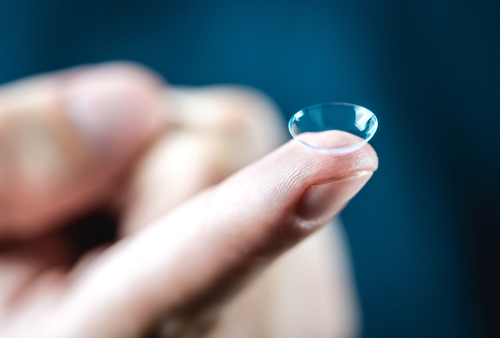
Multifocal contact lenses are a revolutionary optical solution that has transformed the lives of many people around the world. These innovative lenses offer a comprehensive approach to vision correction, capable of addressing multiple vision issues in a single lens. If you're someone who has had to juggle between different pairs of glasses or contact lenses for near and far vision, multifocal contacts are a game-changer.
Multifocal contact lenses are designed to provide clear vision at all distances. They are a fantastic option for individuals experiencing presbyopia - a common condition that affects your ability to focus on close objects as you age. These lenses can also be used to correct other vision problems like myopia (nearsightedness), hyperopia (farsightedness), and astigmatism.
What Are Multifocal Contact Lenses?
Multifocal contact lenses are a type of progressive lens that offers multiple prescriptions in one lens. This type of lens design allows you to see clearly at various distances without needing to switch between different pairs of glasses or contacts. Think of multifocal contacts as the optical equivalent of a Swiss Army knife: they're versatile and can address a range of vision issues.
These lenses are divided into different zones or rings of vision. The central zone typically corrects for distance vision, while the surrounding zones correct for intermediate and near vision. Some multifocal lenses have a gradual transition between zones, mimicking the natural focusing ability of the eye.
Multifocal contact lenses come in different designs and materials and can be customized to fit your specific vision needs and lifestyle. Whether you prefer soft or rigid gas permeable lenses, daily or extended wear options, there's a multifocal contact lens out there for you.
4 Essential Tips for Maximizing Success with Multifocal Contact Lenses
Now that you understand what multifocal contacts are and how they work, it's time to explore how to maximize your success with these lenses. Here are four essential tips to help you get the most out of your multifocal contact lens experience.
Tip 1: Understanding Your Prescription
Understanding your prescription is the first step to success with multifocal contact lenses. Your prescription provides essential information about your vision and the specific corrections you need. It's more than just a series of numbers and abbreviations - it's a roadmap to clear, comfortable vision.Your eye doctor will determine your prescription after a comprehensive eye exam. They'll assess your distance vision, near vision, and any astigmatism you might have. Once your prescription is determined, you and your eye doctor can discuss the best multifocal contact lens options for you.
Remember, your prescription is unique to you, and understanding it can help you make informed decisions about your eye care. So, don't hesitate to ask your eye doctor any questions you might have about your prescription.
Tip 2: Proper Care for Multifocal Contacts
Proper care and maintenance of your multifocal contact lenses are crucial for their performance and longevity, not to mention your eye health. Contact lenses are medical devices, and they need to be handled with care.
First, always wash your hands before handling your lenses. Dirt and bacteria can easily transfer from your hands to your lenses, causing discomfort and potentially serious eye infections. Also, make sure to use the correct cleaning solution recommended by your eye doctor - not all solutions are suitable for all types of lenses.
Always store your lenses in a clean case filled with fresh solution. Never reuse solution, as it loses its disinfecting power over time. Replace your case every three months to avoid bacterial buildup and replace your lenses as directed by your eye doctor.
Tip 3: Patient Adaptation and Practice
Adapting to multifocal contact lenses can take some time and patience. If you're new to these lenses, you might initially experience some vision fluctuations as your eyes adjust to the different zones of the lens. This is completely normal and typically resolves within a week or two.
To help speed up the adaptation process, try to wear your new multifocal contacts for most of the day, gradually increasing the wearing time. This will give your brain a chance to get used to the new visual input.
Practice makes perfect. Spend some time each day focusing on objects at different distances to help your eyes get used to switching between the different zones of your lenses.
Tip 4: Regular Check-Ups and Adjustments
Regular check-ups with your eye doctor are essential for maintaining optimal vision and eye health. Your eye doctor will assess the fit and performance of your multifocal contact lenses and make any necessary adjustments to your prescription.
Your vision can change over time due to various factors, including aging, health conditions, and lifestyle changes. Regular eye exams ensure that your prescription stays up-to-date and that your lenses continue to provide clear, comfortable vision.
Your eye doctor can detect and address any potential eye health issues early on, before they become more serious. So, don't skip your regular eye exams - they're an important part of your overall eye care routine.
Conclusion
Multifocal contact lenses offer a convenient and versatile solution for vision correction. They can provide clear vision at all distances, reducing the need for multiple pairs of glasses or contacts. However, maximizing success with these lenses requires understanding your prescription, proper lens care, patient adaptation, and regular check-ups.
By following these four essential tips, you can enjoy the many benefits of multifocal contact lenses and experience a significant improvement in your quality of life.
For more on maximizing your success with multifocal contact lenses, visit Crystal View Optometry at our office in Elk Grove or Grass Valley, California. Call (916) 681-1101 or (530) 272-2238 to discuss any questions with our team of experts or to schedule an appointment today.









